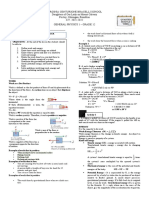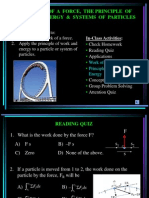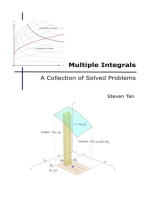Announcements: Test Wednesday
Announcements: Test Wednesday
Uploaded by
kenjam89mbCopyright:
Available Formats
Announcements: Test Wednesday
Announcements: Test Wednesday
Uploaded by
kenjam89mbOriginal Description:
Original Title
Copyright
Available Formats
Share this document
Did you find this document useful?
Is this content inappropriate?
Copyright:
Available Formats
Announcements: Test Wednesday
Announcements: Test Wednesday
Uploaded by
kenjam89mbCopyright:
Available Formats
Announcements
• Test Wednesday
– Closed book
– 3 page sheet sheet (on web)
– Calculator
– Chap 12.6-10, 13.1-6
Principle of Work and Energy - Sections 14.1-3
Today’s Objectives:
Students will be able to:
a) Calculate the work of a force.
b) Apply the principle of work
and energy to a particle or
system of particles. In-Class Activities:
• Reading quiz
• Applications
• Work of a force
• Principle of work and
energy
• Concept quiz
• Group problem solving
• Attention quiz
Engr222 Spring 2004 Chapter 14 1
Reading Quiz
F
1. What is the work done by the force F ?
A) F s B) –F s s1 s2
C) Zero D) None of the above s
2. If a particle is moved from 1 to 2, the work done on the
particle by the force, FR will be
s2 s2
A) ΣFt ds B) − ΣFt ds
s1 s1
s2 s2
C) s1
ΣFn ds D) − s1
ΣFn ds
Applications
A roller coaster makes use of
gravitational forces to assist the
cars in reaching high speeds in the
“valleys” of the track.
How can we design the track (e.g., the height, h, and the
radius of curvature, ρ) to control the forces experienced by
the passengers?
Engr222 Spring 2004 Chapter 14 2
Applications - continued
Crash barrels are often used along
roadways for crash protection. The
barrels absorb the car’s kinetic energy
by deforming.
If we know the typical velocity of an
oncoming car and the amount of energy
that can be absorbed by each barrel, how
can we design a crash cushion?
Work and Energy
Another equation for working kinetics problems involving
particles can be derived by integrating the equation of motion
(F = ma) with respect to displacement.
By substituting at = v (dv/ds) into Ft = mat, the result is
integrated to yield an equation known as the principle of
work and energy.
This principle is useful for solving problems that involve
force, velocity, and displacement. It can also be used to
explore the concept of power.
To use this principle, we must first understand how to
calculate the work of a force.
Engr222 Spring 2004 Chapter 14 3
Work of a Force
A force does work on a particle when the particle undergoes
a displacement along the line of action of the force.
Work is defined as the product of force
and displacement components acting in
the same direction. So, if the angle
between the force and displacement
vector is θ, the increment of work dU
done by the force is
dU = F ds cos θ
By using the definition of the dot product r2
and integrating, the total work can be U =
1-2 F • dr
written as r1
Work of a Force - continued
If F is a function of position (a common case) this becomes
s2
U1-2 = F cos θ ds
s1
If both F and θ are constant (F = Fc), this equation further
simplifies to
U1-2 = Fc cos θ (s2 - s1)
Work is positive if the force and the movement are in the
same direction. If they are opposing, then the work is
negative. If the force and the displacement directions are
perpendicular, the work is zero.
Engr222 Spring 2004 Chapter 14 4
Work of a Weight
The work done by the gravitational force acting on a particle
(or weight of an object) can be calculated by using
y2
U1-2 = - W dy = - W (y2 - y1) = - W ∆y
y1
The work of a weight is the product of the magnitude of
the particle’s weight and its vertical displacement. If
∆y is upward, the work is negative since the weight
force always acts downward.
Work of a Spring Force
When stretched, a linear elastic spring
develops a force of magnitude Fs = ks, where
k is the spring stiffness and s is the
displacement from the unstretched position.
The work of the spring force moving from position s1 to position
s2 is s2 s2
U1-2 = Fs ds = k s ds = 0.5k(s2)2 - 0.5k(s1)2
s1 s1
If a particle is attached to the spring, the force Fs exerted on the
particle is opposite to that exerted on the spring. Thus, the work
done on the particle by the spring force will be negative or
U1-2 = – [ 0.5k (s2)2 – 0.5k (s1)2 ].
Engr222 Spring 2004 Chapter 14 5
Spring Forces
It is important to note the following about spring forces:
1. The equations just shown are for linear springs only.
Recall that a linear spring develops a force according to
F = ks (essentially the equation of a line).
2. The work of a spring is not just spring force times distance
at some point, i.e., (ksi)(si).
3. Always double check the sign of the spring work after
calculating it. It is positive work if the force put on the object
by the spring and the movement are in the same direction.
Principle of Work and Energy
By integrating the equation of motion, Ft = mat = mv(dv/ds), the
principle of work and energy can be written as
U1-2 = 0.5m(v2)2 – 0.5m(v1)2 or T1 + U1-2 = T2
U1-2 is the work done by all the forces acting on the particle as it
moves from point 1 to point 2. Work can be either a positive or
negative scalar.
T1 and T2 are the kinetic energies of the particle at the initial and final
position, respectively. Thus, T1 = 0.5 m (v1)2 and T2 = 0.5 m (v2)2.
The kinetic energy is always a positive scalar (velocity is squared!).
So, the particle’s initial kinetic energy plus the work done by all the
forces acting on the particle as it moves from its initial to final position
is equal to the particle’s final kinetic energy.
Engr222 Spring 2004 Chapter 14 6
Principle of Work and Energy - continued
Note that the principle of work and energy (T1 + U1-2 = T2)
is not a vector equation. Each term results in a scalar value.
Both kinetic energy and work have the same units, that of
energy. In the SI system, the unit for energy is called a joule (J),
where 1 J = 1 N·m. In the FPS system, units are ft·lb.
The principle of work and energy cannot be used, in general, to
determine forces directed normal to the path, since these forces
do no work.
The principle of work and energy can also be applied to a system
of particles by summing the kinetic energies of all particles in the
system and the work due to all forces acting on the system.
Example
Given:A 0.5 kg ball of negligible size is fired
up a vertical track of radius 1.5 m using
a spring plunger with k = 500 N/m.
The plunger keeps the spring
compressed 0.08 m when s = 0.
Find: The distance s the plunger must be pulled back and
released so the ball will begin to leave the track when
θ = 135°.
Plan: 1) Draw the FBD of the ball at θ = 135°.
2) Apply the equation of motion in the n-direction to
determine the speed of the ball when it leaves the
track.
3) Apply the principle of work and energy to determine s.
Engr222 Spring 2004 Chapter 14 7
Example - continued
Solution:
1) Draw the FBD of the ball at θ = 135°.
t N
The weight (W) acts downward through the
center of the ball. The normal force exerted
by the track is perpendicular to the surface.
n The friction force between the ball and the
45° track has no component in the n-direction.
W
2) Apply the equation of motion in the n-direction. Since the
ball leaves the track at θ = 135°, set N = 0.
=> + Fn = man = m (v2/ρ) => W cos45° = m (v2/ρ)
=> (0.5)(9.81) cos 45° = (0.5/1.5)v2 => v = 3.2257 m/s
Example - continued
3) Apply the principle of work and energy between position 1
(θ = 0) and position 2 (θ = 135°). Note that the normal force
(N) does no work since it is always perpendicular to the
displacement direction.
T1 + U1-2 = T2
0.5m (v1 )2 – W ∆y – (0.5k(s2)2 – 0.5k (s1)2) = 0.5m (v2)2
and v1 = 0, v2 = 3.2257 m/s
s1 = s + 0.08 m, s2 = 0.08 m
∆y = 1.5 + 1.5 sin 45° = 2.5607 m
=> 0 – (0.5)(9.81)(2.5607) – [0.5(500)(0.08)2 – 0.5(500)(5 + 0.08)2]
= 0.5(0.5)(3.2257)2
=> s = 0.179 m = 179 mm
Engr222 Spring 2004 Chapter 14 8
Concept Quiz
1. A spring with an unstretched length of 5 in. expands from a
length of 2 in to a length of 4 in. The work done on the spring
is _________ in·lb.
A) 0.5 k (2 in)2 B) - [0.5 k(4 in)2 - 0.5 k(2 in)2]
C) - [0.5 k(3 in)2 - 0.5 k(1 in)2] D) 0.5 k(3 in)2 - 0.5 k(1 in)2
2. Two blocks are initially at rest. How many equations
would be needed to determine the velocity of block A after
block B moves 4 m horizontally on the smooth surface?
A) One B) Two
2 kg
C) Three D) Four
2 kg
Group Problem Solving
Given: Block A has a weight of 60 lb and
block B has a weight of 10 lb. The
coefficient of kinetic friction between
block A and the incline is µk = 0.2.
Neglect the mass of the cord and pulleys.
Find: The speed of block A after it moves 3 ft down the plane,
starting from rest.
Plan: 1) Define the kinematic relationships between the blocks.
2) Draw the FBD of each block.
3) Apply the principle of work and energy to the system
of blocks.
Engr222 Spring 2004 Chapter 14 9
Group Problem Solving - continued
Solution:
1) The kinematic relationships can be determined by defining
position coordinates sA and sB, and then differentiating.
sA Since the cable length is constant:
2sA + sB = l
2∆sA + ∆sB = 0
sB
∆sA = 3ft => ∆sB = -6 ft
and 2vA + vB = 0
=> vB = -2vA
Note that, by this definition of sA and sB, positive motion
for each block is defined as downwards.
Group Problem Solving - continued
2) Draw the FBD of each block.
T
WA
2T
y
x
B
A µNA
5
3 NA
4 WB
Sum forces in the y-direction for block A (note that there is no
motion in this direction):
Fy = 0: NA –(4/5)WA = 0 => NA = (4/5)WA
Engr222 Spring 2004 Chapter 14 10
Group Problem Solving - continued
3) Apply the principle of work and energy to the system (the
blocks start from rest).
T1 + U1-2 = T2
(0.5mA(vA1)2 + .5mB(vB1)2) + ((3/5)WA – 2T – µNA)∆sA
+ (WB – T)∆sB = (0.5mA(vA2)2 + 0.5mB(vB2)2)
vA1 = vB1 = 0, ∆sA = 3ft, ∆sB = -6 ft, vB = -2vA, NA = (4/5)WA
=> 0 + 0 + (3/5)(60)(3) – 2T(3) – (0.2)(0.8)(60)(3) + (10)(-6)
– T(-6) = 0.5(60/32.2)(vA2)2 + 0.5(10/32.2)(-2vA2)2
=> vA2 = 3.52 ft/s
Note that the work due to the cable tension force on each block
cancels out.
Attention Quiz
1. What is the work done by the normal
force N if a 10 lb box is moved from A
to B ?
N
A) - 1.24 lb·ft B) 0 lb·ft
B
C) 1.24 lb·ft D) 2.48 lb·ft
2. If a spring force is F = 5s3 N/m and the spring is compressed
by s = 0.5 m, the work done on a particle attached to the
spring will be
A) 0.625 N·m B) – 0.625 N·m
C) 0.0781 N·m D) – 0.0781 N·m
Engr222 Spring 2004 Chapter 14 11
Textbook Problem 14-
Announcements
Engr222 Spring 2004 Chapter 14 12
Power and Efficiency - Section 14.4
Today’s Objectives:
Students will be able to:
a) Determine the power
generated by a machine,
engine, or motor.
b) Calculate the mechanical
efficiency of a machine. In-Class Activities:
• Reading quiz
• Applications
• Define power
• Define efficiency
• Concept quiz
• Group problem solving
• Attention quiz
Reading Quiz
1. The formula definition of power is ___________.
A) dU / dt B) F • v
C) F • dr/dt D) All of the above.
2. Kinetic energy results from _______.
A) displacement B) velocity
C) gravity D) friction
Engr222 Spring 2004 Chapter 14 13
Applications
Engines and motors are often rated in
terms of their power output. The power
requirements of the motor lifting this
elevator depend on the vertical force F that
acts on the elevator, causing it to move
upwards.
Given the desired lift velocity for the elevator, how can
we determine the power requirement of the motor?
Applications - continued
The speed at which a vehicle can
climb a hill depends in part on the
power output of the engine and the
angle of inclination of the hill.
For a given angle, how can we determine the speed of this
jeep, knowing the power transmitted by the engine to the
wheels?
Engr222 Spring 2004 Chapter 14 14
Power
Power is defined as the amount of work performed per unit
of time.
If a machine or engine performs a certain amount of work,
dU, within a given time interval, dt, the power generated can
be calculated as
P = dU/dt
Since the work can be expressed as dU = F • dr, the power
can be written
P = dU/dt = (F • dr)/dt = F • (dr/dt) = F • v
Thus, power is a scalar defined as the product of the force
and velocity components acting in the same direction.
Power - continued
Using scalar notation, power can be written
P = F • v = F v cos θ
where θ is the angle between the force and velocity vectors.
So if the velocity of a body acted on by a force F is known,
the power can be determined by calculating the dot product
or by multiplying force and velocity components.
The unit of power in the SI system is the watt (W) where
1 W = 1 J/s = 1 (N ·m)/s .
In the FPS system, power is usually expressed in units of
horsepower (hp) where
1 hp = 550 (ft · lb)/s = 746 W .
Engr222 Spring 2004 Chapter 14 15
Efficiency
The mechanical efficiency of a machine is the ratio of the
useful power produced (output power) to the power supplied
to the machine (input power) or
ε = (power output)/(power input)
If energy input and removal occur at the same time, efficiency
may also be expressed in terms of the ratio of output energy
to input energy or
ε = (energy output)/(energy input)
Machines will always have frictional forces. Since frictional
forces dissipate energy, additional power will be required to
overcome these forces. Consequently, the efficiency of a
machine is always less than 1.
Solving Problems
• Find the resultant external force acting on the body causing
its motion. It may be necessary to draw a free-body diagram.
• Determine the velocity of the point on the body at which the
force is applied. Energy methods or the equation of motion
and appropriate kinematic relations, may be necessary.
• Multiply the force magnitude by the component of velocity
acting in the direction of F to determine the power supplied
to the body (P = F v cos θ).
• In some cases, power may be found by calculating the work
done per unit of time (P = dU/dt).
• If the mechanical efficiency of a machine is known, either
the power input or output can be determined.
Engr222 Spring 2004 Chapter 14 16
Example
Given:A sports car has a mass of 2 Mg and an engine efficiency
of ε = 0.65. Moving forward, the wind creates a drag
resistance on the car of FD = 1.2v2 N, where v is the
velocity in m/s. The car accelerates at 5 m/s2, starting
from rest.
Find: The engine’s input power when t = 4 s.
Plan: 1) Draw a free body diagram of the car.
2) Apply the equation of motion and kinematic equations
to find the car’s velocity at t = 4 s.
3) Determine the power required for this motion.
4) Use the engine’s efficiency to determine input power.
Example - continued
Solution:
1) Draw the FBD of the car.
The drag force and weight are
known forces. The normal force Nc
and frictional force Fc represent the
resultant forces of all four wheels.
The frictional force between the
wheels and road pushes the car
forward.
2) The equation of motion can be applied in the x-direction,
with ax = 5 m/s2:
+ Fx = max => Fc – 1.2v2 = (2000)(5)
=> Fc = (10,000 + 1.2v2) N
Engr222 Spring 2004 Chapter 14 17
Example - continued
3) The constant acceleration equations can be used to
determine the car’s velocity.
vx = vxo + axt = 0 + (5)(4) = 20 m/s
4) The power output of the car is calculated by multiplying the
driving (frictional) force and the car’s velocity:
Po = (Fc)(vx ) = [10,000 + (1.2)(20)2](20) = 209.6 kW
5) The power developed by the engine (prior to its frictional
losses) is obtained using the efficiency equation.
Pi = Po/ε = 209.6/0.65 = 322 kW
Concept Quiz
1. A motor pulls a 10 lb block up a smooth
incline at a constant velocity of 4 ft/s. 30º
Find the power supplied by the motor.
A) 8.4 ft·lb/s B) 20 ft·lb/s
C) 34.6 ft·lb/s D) 40 ft·lb/s
2. A twin engine jet aircraft is climbing at a 10 degree angle
at 264 ft/s. The thrust developed by a jet engine is 1000 lb.
The power developed by the engines is
A) (1000 lb)(140 ft/s) B) (2000 lb)(140 ft/s) cos 10
C) (1000 lb)(140 ft/s) cos 10 D) (2000 lb)(140 ft/s)
Engr222 Spring 2004 Chapter 14 18
Group Problem Solving
Given: A 50-lb load (B) is hoisted by the pulley
system and motor M. The motor has an
efficiency of 0.76 and exerts a constant
force of 30 lb on the cable. Neglect the
mass of the pulleys and cable.
Find: The power supplied to the motor when the load has been
hoisted 10 ft. The block started from rest.
Plan: 1) Relate the cable and block velocities by defining
position coordinates. Draw a FBD of the block.
2) Use the equation of motion or energy methods to
determine the block’s velocity at 10 feet.
3) Calculate the power supplied by the motor and to the
motor.
Group Problem Solving - continued
Solution:
1) Define position coordinates to relate velocities.
sm
Here sm is defined to a point on the cable. Also sB
sB is defined only to the lower pulley, since the block
moves with the pulley. From kinematics,
sm + 2sB = l
=> vm + 2vB = 0
=> vm = -2vB
Draw the FBD of the block:
2T
Since the pulley has no mass, a force
balance requires that the tension in the
B
lower cable is twice the tension in the upper
WB = 50 lb cable.
Engr222 Spring 2004 Chapter 14 19
Group Problem Solving - continued
2) The velocity of the block can be obtained by
applying the principle of work and energy to the
block (recall that the block starts from rest).
+ T1 + U1-2 = T2
0.5m(v1)2 + [2T(s) – wB(s)] = 0.5m (v2)2
0 + [2(30)(10) - (50)(10)] = 0.5(50/32.2)(v2)2
=> v2 = vB = 11.35 ft/s
Since this velocity is upwards, it is a negative velocity in
terms of the kinematic equation coordinates.
The velocity of the cable coming into the motor (vm) is
calculated from the kinematic equation.
vm = - 2vB = - (2)(-11.35) = 22.70 ft/s
Group Problem Solving - continued
3) The power supplied by the motor is the product of the force
applied to the cable and the velocity of the cable:
Po = F • v = (30)(22.70) = 681 (ft ·lb)/s
The power supplied to the motor is determined using the
motor’s efficiency and the basic efficiency equation.
Pi = Po/ε = 681/0.76 = 896 (ft ·lb)/s
Converting to horsepower
Pi = 896/550 = 1.63 hp
Engr222 Spring 2004 Chapter 14 20
Attention Quiz
1. The power supplied by a machine will always be
_________ the power supplied to the machine.
A) less than B) equal to
C) greater than D) A or B
2. A car is traveling a level road at 88 ft/s. The power being
supplied to the wheels is 52,800 ft·lb/s. Find the
combined friction force on the tires.
A) 8.82 lb B) 400 lb
C) 600 lb D) 4.64 x 106 lb
Textbook Problem 14-
Engr222 Spring 2004 Chapter 14 21
Announcements
Potential Energy and Conservation of Energy
Sections 14.5-6
Today’s Objectives:
Students will be able to:
a) Understand the concept of
conservative forces and
determine the potential
energy of such forces. In-Class Activities:
b) Apply the principle of • Reading quiz
conservation of energy. • Applications
• Conservative force
• Potential energy
• Conservation of energy
• Concept quiz
• Group problem solving
• Attention quiz
Engr222 Spring 2004 Chapter 14 22
Reading Quiz
1. The potential energy of a spring is
A) always negative. B) always positive.
C) positive or negative. D) equal to ks.
2. When the potential energy of a conservative system
increases, the kinetic energy
A) always decreases. B) always increases.
C) could decrease or D) does not change.
increase.
Applications
The weight of the sacks resting on this platform causes
potential energy to be stored in the supporting springs.
If the sacks weigh 100 lb and the equivalent spring constant
is k = 500 lb/ft, what is the energy stored in the springs?
Engr222 Spring 2004 Chapter 14 23
Applications - continued
When a ball of weight W is dropped (from rest) from a height
h above the ground, the potential energy stored in the ball is
converted to kinetic energy as the ball drops.
What is the velocity of the ball when it hits the ground? Does
the weight of the ball affect the final velocity?
Conservative Force
A force F is said to be conservative if the work done is
independent of the path followed by the force acting on a particle
as it moves from A to B. In other words, the work done by the
force F in a closed path (i.e., from A to B and then back to A)
equals zero.
F · dr = 0 z B
F
This means the work is conserved.
A
A conservative force depends y
only on the position of the
particle, and is independent of its
velocity or acceleration.
x
Engr222 Spring 2004 Chapter 14 24
Conservative Force - continued
A more rigorous definition of a conservative force makes
use of a potential function (V) and partial differential
calculus, as explained in the textbook. However, even
without the use of the these mathematical relationships,
much can be understood and accomplished.
The “conservative” potential energy of a particle/system is
typically written using the potential function V. There are two
major components to V commonly encountered in mechanical
systems, the potential energy from gravity and the potential
energy from springs or other elastic elements.
V total = V gravity + V springs
Potential Energy
Potential energy is a measure of the amount of work a
conservative force will do when it changes position.
In general, for any conservative force system, we can define
the potential function (V) as a function of position. The work
done by conservative forces as the particle moves equals the
change in the value of the potential function (the sum of
Vgravity and Vsprings).
It is important to become familiar with the two types of
potential energy and how to calculate their magnitudes.
Engr222 Spring 2004 Chapter 14 25
Potential Energy Due to Gravity
The potential function (formula) for a gravitational force, e.g.,
weight (W = mg), is the force multiplied by its elevation from a
datum. The datum can be defined at any convenient location.
Vg = +_ W y
Vg is positive if y is
above the datum and
negative if y is
below the datum.
Remember, YOU get
to set the datum.
Elastic Potential Energy
Recall that the force of an elastic spring is F = ks. It is
important to realize that the potential energy of a spring, while
it looks similar, is a different formula.
Ve (where ‘e’ denotes an
elastic spring) has the distance
“s” raised to a power (the
result of an integration) or
1 2
Ve = ks
2
Notice that the potential
function Ve always yields
positive energy.
Engr222 Spring 2004 Chapter 14 26
Conservation of Energy
When a particle is acted upon by a system of conservative
forces, the work done by these forces is conserved and the
sum of kinetic energy and potential energy remains
constant. In other words, as the particle moves, kinetic
energy is converted to potential energy and vice versa.
This principle is called the principle of conservation of
energy and is expressed as
T1 + V1 = T2 + V2 = Constant
T1 stands for the kinetic energy at state 1 and V1 is the
potential energy function for state 1. T2 and V2
represent these energy states at state 2. Recall, the
kinetic energy is defined as T = ½ mv2.
Example
Given: The girl and bicycle
weigh 125 lbs. She moves from
point A to B.
Find: The velocity and the
normal force at B if the velocity
at A is 10 ft/s and she stops
pedaling at A.
Plan: Note that only kinetic energy and potential energy due
to gravity (Vg) are involved. Determine the velocity at B
using the conservation of energy equation and then apply
equilibrium equations to find the normal force.
Engr222 Spring 2004 Chapter 14 27
Example - continued
Solution:
Placing the datum at B:
TA + VA = TB + VB
1 125 1 125 2
)(10) + 125(30) = (
2
( )v
2 32.2 2 32.2 B
VB = 45.1 ft
s
Equation of motion applied at B:
v2
Fn = man = m ρ
125 ( 45.1) 2
NB − 125 =
32.2 50
N B = 283 lb
Concept Quiz
1. If the work done by a conservative force on a particle as it
moves between two positions is –10 ft-lb, the change in its
potential energy is
A) 0 ft-lb. B) -10 ft-lb.
C) +10 ft-lb. D) None of the above.
2. Recall that the work of a spring is U1-2 = -½ k(s22 – s12) and
can be either positive or negative. The potential energy of a
spring is V = ½ ks2 . Its value is
A) always negative. B) either positive or negative.
C) always positive. D) an imaginary number!
Engr222 Spring 2004 Chapter 14 28
Group Problem Solving
Given: The mass of the collar is 2 kg and
the spring constant is 60 N/m. The
collar has no velocity at A and the
spring is un-deformed at A.
Find: The maximum distance y the collar
drops before it stops at Point C.
Plan: Apply the conservation of energy equation between A
and C. Set the gravitational potential energy datum at
point A or point C (in this example, choose point A).
Group Problem Solving - continued
Solution:
Notice that the potential energy at C has two parts (Tc = 0).
Vc = (Vc)e + (Vc)g
Placing the datum for gravitational potential at A yields a
conservation of energy equation with the left side all zeros.
Since Tc equals zero at points A and C, the equation becomes
60
0 + 0 = 0 + [ ( (.75) 2 + y 2 − .75) 2 − 2(9.81) y ]
2
Note that (Vc)g is negative since point C is below the datum.
Since the equation is nonlinear, a numerical solver can be
used to find the solution or root of the equation. This solving
routine can be done with a calculator or a program like Excel.
The solution yields y = 1.61 m.
Engr222 Spring 2004 Chapter 14 29
Group Problem Solving - continued
Also notice that since the velocities at A and C are zero, the
velocity must reach a maximum somewhere between A and C.
Since energy is conserved, the point of maximum kinetic energy
(maximum velocity) corresponds to the point of minimum
potential energy.
By expressing the potential energy at any given position as a
function of y and then differentiating, we can determine the
position at which the velocity is maximum (since dV/dy = 0 at
this position). The derivative yields another nonlinear equation
which could be solved using a numerical solver.
Attention Quiz
1. The principle of conservation of energy is usually ______ to
apply than the principle of work & energy.
A) harder B) easier
C) the same amount of work D) Don’t pick this one.
2. If the pendulum is released from the
horizontal position, the velocity of its
bob in the vertical position is
A) 3.8 m/s. B) 6.9 m/s.
C) 14.7 m/s. D) 21 m/s.
Engr222 Spring 2004 Chapter 14 30
Textbook Problem 14-
Engr222 Spring 2004 Chapter 14 31
You might also like
- PYROVATEX Technical Brochure APRIL 20 2012 LRDocument20 pagesPYROVATEX Technical Brochure APRIL 20 2012 LRvenkattexNo ratings yet
- 212808400-SNI-15-0047-2005-KACA 20-28 EngDocument9 pages212808400-SNI-15-0047-2005-KACA 20-28 EngAdul JagoNo ratings yet
- Chapter14 PDFDocument31 pagesChapter14 PDFgykirankcNo ratings yet
- Scee 271 14 Sec 1 4 PDFDocument40 pagesScee 271 14 Sec 1 4 PDFgykirankcNo ratings yet
- Em ppt1 PDFDocument53 pagesEm ppt1 PDFsuresh muniyandiNo ratings yet
- The Work of A Force, The Principle of Work and Energy & Systems of ParticlesDocument27 pagesThe Work of A Force, The Principle of Work and Energy & Systems of ParticlesAtef NazNo ratings yet
- week4Document90 pagesweek4rina19306344No ratings yet
- CH 14 - Work and Energy With SolutionsDocument99 pagesCH 14 - Work and Energy With Solutionsmargaritaduarte2015.mdNo ratings yet
- Dynamics - Lect PPT 11.1-11.3Document23 pagesDynamics - Lect PPT 11.1-11.3Siti Khadijah Che OsmiNo ratings yet
- Kinetics of Particle Work Energy - ClassDocument46 pagesKinetics of Particle Work Energy - ClassLebogang TlhagwaneNo ratings yet
- Ch03 Kinetics of Particles - Energy&Momentum Methods - Part 1Document48 pagesCh03 Kinetics of Particles - Energy&Momentum Methods - Part 1Mehmet Fatih SunçaNo ratings yet
- ME 230 Kinematics and Dynamics: Wei-Chih WangDocument90 pagesME 230 Kinematics and Dynamics: Wei-Chih WangAlvin CastilloNo ratings yet
- Lecture 11-Section-14.1-14.3Document30 pagesLecture 11-Section-14.1-14.3ericjrayman31No ratings yet
- Kinetics of A Particle: Work and EnergyDocument21 pagesKinetics of A Particle: Work and EnergyziyingkangNo ratings yet
- Chapter 3 Work and Energy MethodDocument23 pagesChapter 3 Work and Energy Methoddudescape100% (1)
- Principle of Work and EnergyDocument19 pagesPrinciple of Work and EnergyzakNo ratings yet
- Dynamics - Chapter 13 (Beer7)Document68 pagesDynamics - Chapter 13 (Beer7)api-370949689% (9)
- Dynamics Chapter 13 Beer7Document68 pagesDynamics Chapter 13 Beer7Sheensky V. SalasaNo ratings yet
- Module 3 Kinetics of A Particle-Work and EnergyDocument65 pagesModule 3 Kinetics of A Particle-Work and EnergyHuy VũNo ratings yet
- M7-Chapter-08-2021Document144 pagesM7-Chapter-08-2021Christopher PettitNo ratings yet
- Kinetics of Particles - Work Done & EnergyDocument50 pagesKinetics of Particles - Work Done & EnergyIzhaar MaudarbocusNo ratings yet
- Lecture 5 Particles Work and EnergyDocument7 pagesLecture 5 Particles Work and Energychan haoNo ratings yet
- 動力學-CH14-質點運動力學 - 功與能-Kinetics of a Particle - Work and EnergyDocument52 pages動力學-CH14-質點運動力學 - 功與能-Kinetics of a Particle - Work and EnergyyusyusiangNo ratings yet
- Work The Scientific Definition 5Document8 pagesWork The Scientific Definition 5Thomas CooperNo ratings yet
- Dowork EnergyDocument56 pagesDowork EnergyEswar AnandNo ratings yet
- Chapter 3 (Autosaved)Document44 pagesChapter 3 (Autosaved)TrueManSoulNo ratings yet
- Chap3 Part 1Document18 pagesChap3 Part 1Jing Kai LumNo ratings yet
- CH 14-1 EMDocument29 pagesCH 14-1 EMhlyanheinhNo ratings yet
- Integrating ( M) With Respect To Displacement: Work and EnergyDocument27 pagesIntegrating ( M) With Respect To Displacement: Work and EnergyAsadNo ratings yet
- 678665598 3 Energy Work and PowerDocument35 pages678665598 3 Energy Work and PowerqqyytryssNo ratings yet
- 5.deflections Using Energy Methods PDFDocument47 pages5.deflections Using Energy Methods PDFengkj100% (1)
- 5.deflections Using Energy Methods PDFDocument47 pages5.deflections Using Energy Methods PDFking burgosNo ratings yet
- Sec14.1 6 - Saba 3Document47 pagesSec14.1 6 - Saba 3wsv6xpqphfNo ratings yet
- Chapter No 14: (SECTIONS 14.1-14.4, 14.6)Document63 pagesChapter No 14: (SECTIONS 14.1-14.4, 14.6)Farhan ShahriarNo ratings yet
- CBSE-XI Physics - Chap-5 (Work, Energy & Power)Document15 pagesCBSE-XI Physics - Chap-5 (Work, Energy & Power)Shubhrojyoti MitraNo ratings yet
- Wpe 1Document40 pagesWpe 1Praveen KiskuNo ratings yet
- Lec 11 Work Energy Method For Particle KineticsDocument34 pagesLec 11 Work Energy Method For Particle KineticsJihan PacerNo ratings yet
- BG CHKC Eng 05deflections R1Document51 pagesBG CHKC Eng 05deflections R1Hoàng ĐứcNo ratings yet
- Chapter 17 Plane Motion of Rigid Bodies (Repaired)Document52 pagesChapter 17 Plane Motion of Rigid Bodies (Repaired)Ng Shin JouNo ratings yet
- Gen Physics q2 Module 1Document3 pagesGen Physics q2 Module 1Lawrence Sean MotinNo ratings yet
- Gen Physics q2 Module 1Document3 pagesGen Physics q2 Module 1Lawrence Sean Motin100% (1)
- Work Power Energy Super JEE Formula Sheet Used by TopperDocument5 pagesWork Power Energy Super JEE Formula Sheet Used by ToppertaanusarvNo ratings yet
- 14.kinetics of A Particle Work and EnergyDocument11 pages14.kinetics of A Particle Work and EnergyrodyNo ratings yet
- Module 3 Kinetics of Particle Energy Work For TeachingDocument6 pagesModule 3 Kinetics of Particle Energy Work For TeachingHannah Mae GuimbonganNo ratings yet
- Kinetics of Particles Energy and Momentum MethodsDocument94 pagesKinetics of Particles Energy and Momentum MethodsAnonymous ANo ratings yet
- CP213: Tutorial Notebook 5Document1 pageCP213: Tutorial Notebook 5Bilal AhmadNo ratings yet
- Kinetics of A Particle: Work and EnergyDocument18 pagesKinetics of A Particle: Work and Energymohdiqbal93No ratings yet
- The Work of A Force, The Principle of Work and Energy & Systems of ParticlesDocument58 pagesThe Work of A Force, The Principle of Work and Energy & Systems of ParticlesChristopher LoArNo ratings yet
- Dynamics: Vector Mechanics For EngineersDocument22 pagesDynamics: Vector Mechanics For EngineersAnonymous ANo ratings yet
- Chapter 14 Kinetics of Particle - Work EnergyDocument37 pagesChapter 14 Kinetics of Particle - Work EnergyISLAMIC VOICENo ratings yet
- PHYS22 en 01 Skills WorkbookDocument4 pagesPHYS22 en 01 Skills Workbookdanaa.elarefNo ratings yet
- Lecture19Notes PMS81Document25 pagesLecture19Notes PMS81fathimalanabza842No ratings yet
- Work Power EnergyDocument28 pagesWork Power EnergyKrsna Jaiswal100% (1)
- Work, Energy noteDocument11 pagesWork, Energy notevishruthamurali2007No ratings yet
- Uyp 2Document3 pagesUyp 2FATIN NOORNo ratings yet
- Lecture 14.KineticEnergyDocument37 pagesLecture 14.KineticEnergyJean Claude CagasNo ratings yet
- Lecture 1.6 - Week 4 Monday - Power Impulse MomentumDocument29 pagesLecture 1.6 - Week 4 Monday - Power Impulse MomentumAmala CuganesanNo ratings yet
- Module 2work and Energy v3Document62 pagesModule 2work and Energy v3Dyas FerNo ratings yet
- KAPITULLI 4 - Puna dhe EnergjiaDocument19 pagesKAPITULLI 4 - Puna dhe Energjiafatjon.musliNo ratings yet
- Understanding Vector Calculus: Practical Development and Solved ProblemsFrom EverandUnderstanding Vector Calculus: Practical Development and Solved ProblemsNo ratings yet
- I. Ii. For: MI/M2 IsDocument1 pageI. Ii. For: MI/M2 Iskenjam89mbNo ratings yet
- As The Gods Will 2014 1080p BRRip x264 DTS-JYKDocument86 pagesAs The Gods Will 2014 1080p BRRip x264 DTS-JYKkenjam89mbNo ratings yet
- Plane 2023 CROSubs WEBRip XviD-metalcampDocument75 pagesPlane 2023 CROSubs WEBRip XviD-metalcampkenjam89mbNo ratings yet
- Eng The - Hitmans.Wifes - Bodyguard.2021.MSMOVIESBD - CODocument176 pagesEng The - Hitmans.Wifes - Bodyguard.2021.MSMOVIESBD - COkenjam89mbNo ratings yet
- Monster Hunter 2020 1080p BluRay DD+5 1 x264-iFTDocument37 pagesMonster Hunter 2020 1080p BluRay DD+5 1 x264-iFTkenjam89mbNo ratings yet
- Cats and Dogs 3 Paws Unite 2020Document138 pagesCats and Dogs 3 Paws Unite 2020kenjam89mbNo ratings yet
- Members Subject To Both and Bending Stresses Must Satisfy The Following EquationDocument1 pageMembers Subject To Both and Bending Stresses Must Satisfy The Following Equationkenjam89mbNo ratings yet
- Beams and Other Flexural MembersDocument9 pagesBeams and Other Flexural Memberskenjam89mbNo ratings yet
- Screenshot 20200625 221451 Com - Adobe.readerDocument1 pageScreenshot 20200625 221451 Com - Adobe.readerkenjam89mbNo ratings yet
- Screenshot 20200625 222118 Com - Adobe.readerDocument1 pageScreenshot 20200625 222118 Com - Adobe.readerkenjam89mbNo ratings yet
- Design of Steel Compression Members (According To Is: 800)Document7 pagesDesign of Steel Compression Members (According To Is: 800)kenjam89mbNo ratings yet
- Screenshot 20200625 222059 Com - Adobe.readerDocument1 pageScreenshot 20200625 222059 Com - Adobe.readerkenjam89mbNo ratings yet
- Combined Axial and Bending Stresses: Beam-ColumnDocument1 pageCombined Axial and Bending Stresses: Beam-Columnkenjam89mbNo ratings yet
- Stabilitii : Chapter 04 - Columns and Other 5 Compression MembersDocument1 pageStabilitii : Chapter 04 - Columns and Other 5 Compression Memberskenjam89mbNo ratings yet
- Geotechnical Structure FailureDocument3 pagesGeotechnical Structure Failurekenjam89mbNo ratings yet
- CEP BleacherDocument23 pagesCEP Bleacherkenjam89mbNo ratings yet
- Proposed Grandstand For Motocross Event at Purok 5Document7 pagesProposed Grandstand For Motocross Event at Purok 5kenjam89mbNo ratings yet
- Princeton PDFDocument3 pagesPrinceton PDFkenjam89mbNo ratings yet
- Cabarroguis Campus: "Molding Minds, Shaping Future"Document1 pageCabarroguis Campus: "Molding Minds, Shaping Future"kenjam89mbNo ratings yet
- Heavy Timber TrussesDocument152 pagesHeavy Timber Trusseskenjam89mbNo ratings yet
- Cheat Codes and Secrets - GTA - San Andreas Wiki Guide - IGN PDFDocument10 pagesCheat Codes and Secrets - GTA - San Andreas Wiki Guide - IGN PDFkenjam89mbNo ratings yet
- Continuation IntersectionDocument28 pagesContinuation Intersectionkenjam89mbNo ratings yet
- Quirino State University: Civil Engineering DepartmentDocument1 pageQuirino State University: Civil Engineering Departmentkenjam89mbNo ratings yet
- Types of Intersection of Roads PDFDocument15 pagesTypes of Intersection of Roads PDFkenjam89mbNo ratings yet
- Presented By: Angelica Jane Guzman and Jay BelmonteDocument25 pagesPresented By: Angelica Jane Guzman and Jay Belmontekenjam89mbNo ratings yet
- Liquid Product Line 2020Document2 pagesLiquid Product Line 2020martinNo ratings yet
- Chemistry SSC 1 Paper I-1Document8 pagesChemistry SSC 1 Paper I-1rabiasehar890No ratings yet
- Marine Science Workbook - Chapter 1Document15 pagesMarine Science Workbook - Chapter 1Prasanth (content)No ratings yet
- Problem Set 26Document9 pagesProblem Set 26Desak MelaNo ratings yet
- Influence of Amorphous Colloidal Silica On The Properties of Self-Compacting ConcretesDocument12 pagesInfluence of Amorphous Colloidal Silica On The Properties of Self-Compacting ConcretesdoxamariaNo ratings yet
- A Rational Approach To Control Valve SizingDocument4 pagesA Rational Approach To Control Valve SizingcymyNo ratings yet
- Philippine Countryville College, Inc: Forensic 3: Forensic Chemistry and ToxicologyDocument6 pagesPhilippine Countryville College, Inc: Forensic 3: Forensic Chemistry and ToxicologyJoshua BaguioNo ratings yet
- Study of Various Electric Control Devices Used in Refrigeration System.Document3 pagesStudy of Various Electric Control Devices Used in Refrigeration System.MohdQasim100% (2)
- Chapter 1Document27 pagesChapter 1Junaid KhaliqNo ratings yet
- Test On Electrolysis Grade IXDocument13 pagesTest On Electrolysis Grade IXkrisnuNo ratings yet
- Nomextechnicalguide PDFDocument40 pagesNomextechnicalguide PDFFran Rodriguez MariscalNo ratings yet
- DFP450W 0 8 InstructionsDocument2 pagesDFP450W 0 8 InstructionsveremoralesNo ratings yet
- Young's ModulusDocument3 pagesYoung's ModulusRjNo ratings yet
- Presentation Dangerous Goods 2019Document51 pagesPresentation Dangerous Goods 2019lyndon_baker_1No ratings yet
- Dense Bituminous MacdamDocument26 pagesDense Bituminous MacdamSakshar HNo ratings yet
- Gut Enzymes Intestines Digestion 1965 Piper 506 8Document4 pagesGut Enzymes Intestines Digestion 1965 Piper 506 8doggydogNo ratings yet
- Prelab 8Document3 pagesPrelab 8nutmeg483No ratings yet
- Catalog Phot Chan Dau SKF PDFDocument488 pagesCatalog Phot Chan Dau SKF PDFBui Duy ThanhNo ratings yet
- CH 8 and 10 - Basic Principles of Atomic Absorption and Atomic Emission SpectrosDocument129 pagesCH 8 and 10 - Basic Principles of Atomic Absorption and Atomic Emission SpectrosfaisalNo ratings yet
- Cot 1 2024Document6 pagesCot 1 2024Emily Dela CruzNo ratings yet
- FPA Guidelines On Biorational PesticidesDocument34 pagesFPA Guidelines On Biorational PesticidesprecauteNo ratings yet
- Models - Mph.vacuum DryingDocument16 pagesModels - Mph.vacuum DryingRF ZDavNo ratings yet
- Itr Repair Parts - Bogie PinsDocument2 pagesItr Repair Parts - Bogie Pinspaulo.alvarez63No ratings yet
- C-Arm IntroductionDocument26 pagesC-Arm Introductionjv007No ratings yet
- Ver.7 Effects of Fibrin 23 and ARG Fibers On Porous ConcreteDocument55 pagesVer.7 Effects of Fibrin 23 and ARG Fibers On Porous ConcreteNico Torres100% (1)
- Chapter One: 1. Introduction To ChemistryDocument10 pagesChapter One: 1. Introduction To Chemistryyohannes lemiNo ratings yet
- Ok Tubrod 15.00A Ok Tubrod 15.14A: A Fully Basic Flux Cored Wire An All-Positional Rutile Flux Cored WireDocument1 pageOk Tubrod 15.00A Ok Tubrod 15.14A: A Fully Basic Flux Cored Wire An All-Positional Rutile Flux Cored WireGokul RajanNo ratings yet

















































































































